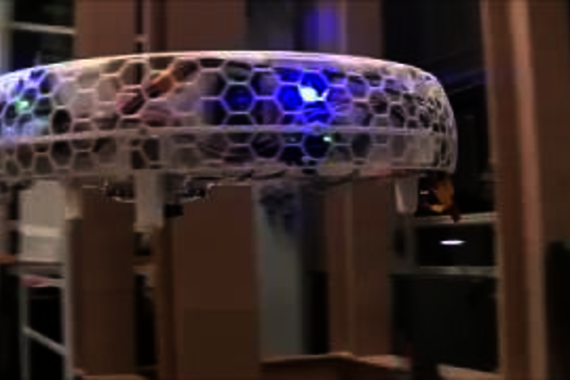![[Translate to English:] Pr-medewerker Emmie Schoutens en teammanager Rik Benoist. Foto | Frits van Otterdijk](/fileadmin/_processed_/1/0/csm_Blue_Jay_1__002__44692f73c9.jpg)
- Research , Student
- 15/02/2019
Blue Jay this time focuses on technology first
When a proposed business plan becomes a bottleneck impeding innovation, only a radical change will help. So for student team Blue Jay this time business comes before pleasure. The students are focusing fully on the technology that can improve their drone. Once that hurdle has been cleared the question will be tackled what the drone can be used for. Yesterday the team gave a demonstration in the new big lecture hall of Atlas.
Blue Jay is a remarkable high-flyer in the world of drones. It moves autonomously through an indoor area and has been designed to help people at close range. The student team working on a new version has now decided on a radical change in course. The question what the purpose is of Blue Jay has been abandoned. “That theme is impeding the improvement of the technology”, say Rik Benoist and Emmie Schoutens of the student team. “First we’re going to make sure of the improvement of the drone, so that we can then see better what kind of purposes it is suited for.”
Until now a business model was linked to each final presentation. Preceding drones served a drink (healthcare), played tic-tac-toc (artificial intelligence) or signaled when somebody was in danger of drowning (safety). No doubt the new Blue Jay could do all of this, but that is not the aim of these students.
Benoist: “Such business models came too early, because the technology was not advanced enough yet. Now we are turning it around. First we focus strongly on technology, then we can automatically tighten up the ‘use case’. Eventually this must in two to three years lead to the ultimate drone that can serve as a basic platform for a number of applications.”
Singlecopter
For team manager Benoist, PR officer Schoutens and the rest of the team the presentation on Thursday afternoon February 14 was a kind of baptism by fire; the first interim presentation of the new drone in the big lecture hall in Atlas. Whereas the previous specimen still counted six propellers, this variant only has four. “We are also following a different course with the development of a ‘singlecopter’. A drone featuring only one propeller can be much smaller and quieter, which is ideal for indoor use”, Schoutens explains.
However, this will definitely not blur the focus on the drone with four propellers, they assure Cursor. Schoutens: “The team is big and varied and consists of nineteen members coming from twelve different degree programs. So we have enough people and resources available.”
In the run-up to the presentation there is still rush hour in Momentum, the building that accommodates Blue Jay. The efforts of the part-timers rocketed from sixteen to forty hours a week in the past few weeks and the full-timers also see their nights and weekends evaporate. Still, the unanimity and spirit are keeping everybody alive, says Schoutens.
Subteams
The student team is divided into five subteams: management, hardware, software, artificial intelligence and interaction design, where it is investigated how drones and humans can communicate optimally. Backed financially by TU/e the team is working on the golden formula and in these efforts it is supported with knowledge and facilities by companies such as Fortress, NXP and SAS. In turn, the students are sharing their data. There is always ample interest from the outside world, both nationally and internationally, says Benoist, “for autonomous and indoors is a combination seldom seen.”
Other striking alterations to the drone concern the protective plastic frame, which has now been traded in for a version in which canvas has been used. This has reduced the weight of Blue Jay from 2.6 to 2.2 kilos and we are still counting, says Benoist. “In a few weeks’ time we shall approach the weight of two kilos”, he predicts. “Our pursuit is to bring it below two kilos.” The ‘eyes’ of the drone have been given a heart shape, while the LED lights are pink. Speech has been added as an extra form of communication between man and machine. On that point Benoist observes: “We are making the drone lively alright, though not too human, for that would only be scary.”
Interested in hearing more about team Blue Jay? Feel free to contact them.

![[Translate to English:] Pr-medewerker Emmie Schoutens en teammanager Rik Benoist. Foto | Frits van Otterdijk [Translate to English:] Pr-medewerker Emmie Schoutens en teammanager Rik Benoist. Foto | Frits van Otterdijk](/fileadmin/_processed_/d/b/csm_Blue_Jay_2__002__b0991eaa58.jpg)
Discussion